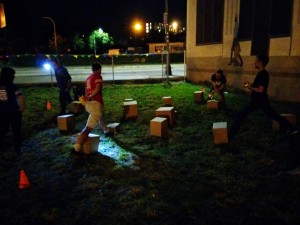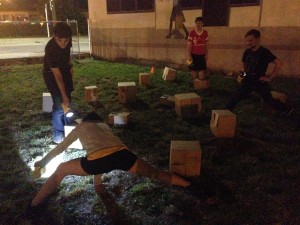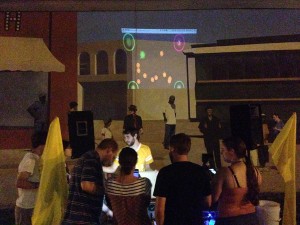Game 1: Nashville
A deck of cards is split into black and red cards, 2s and jokers removed. The face cards are handed out randomly to a group of people. Those who get black cards are the bandit, those who get red cards are the law. The black king signifies the bandit head honcho, the red king is the sheriff. The rest of the cards are split up according to team, so that the bandits have all the black cards from 3-10 and the law has all the red cards from 3-10. There are two parts of game play.
The first part is a series of shootouts, where each player engages in a shootout with a member of the opposite team and “draws” a card of their choice from their hand. Whoever’s card is higher wins the shootout and gets to select a card from the loser’s hand to save for the boss’s clip during the boss shootout. The “shot” during each shootoff are torn in half so they can’t be used again. After 30 minutes, players give any cards they have won to their boss. Any unused cards serve a special purpose.
The second part of play is a boss shootout. This involves the bosses taking all of the cards collected by their team and having a massive shootout. Any unused cards can be used to “deflect” enemy fire if they are the same number. Whichever boss is left standing at the end wins.
This game was exciting, but 30 minutes was entirely too long for 2 teams of 5 to have all their shootouts. I think if the terrain had been more challenging than a parking lot then the time limit would have made sense to hide out and ambush the enemy to ensure they had no cards left to deflect with. As it was, many people left for the 30 minutes after about 3 minutes of shootouts in quick succession to play other games in the meantime. The game worked, I just think that either more strongly encouraging role play or having a shorter amount of time would greatly improve it.
Game 2: Unwanted Entities
The players goal is to earn more points than the other team by trying to occupy higher value properties with their own Figures. Part of the strategy is cleaning high value properties from Gray Figures by displacing them onto properties with lower value or placing them onto the other team’s property and outnumbering their figures with grey ones.
You claim a property by placing your figures on them. You can place each of your figures only once. If they are kicked out of a property by a pedestrian, you will loose that figure, you are not allowed to place them back in. Tip: Use your body to protect your figures from pedestrian. You are not allowed to remove the other teams figures or ask non player pedestrians to do so. Play fair!
You can move the Gray Figures freely from one property to another. Players must not carry more than one Gray Figure at a time. You must not place any of your figures until you have placed the Gray Figure in a new property.
Every Team has one special figure, represented by a larger game piece: The King. The King counts as 5 little figures and doubles the value of the zone it is placed in. For example, if there is a red King and three green figures on a zone valued 50 – red earns 100 points. If there are six red figures and a green King on a zone valued 30, read earns 60 points. If two teams place their King on one zone, the value is doubled only once.
Playing time is around 8 minutes after which points are counted. The team who has the most figures on a property cashes in the points for the property. In case of a tie, no-one gets any points. If there are more Gray Figures in a zone than any other colors, the Gray Figures cash in the points. The Gray Figures can win the game.
The referee and her helpers can celebrate the counting of points by doing a procession from property to property, collecting the figures and announcing the points through walkie-talkies. It is also very nice to have some music to go along with the procession.
We kind of broke this game. I think it was because there weren’t enough players or it wasn’t explained thoroughly. Our strategy (3 people) was to have everyone switch off being the mover so legs stayed fresh. Mover would move unwanted entities between 2 high-point properties so builders could build quickly. When we ran out of materials we started dropping our unwanted entities on other people’s highest point properties. We picked the furthest corner so nobody dropped any unwanted entities on us.
It wasn’t explained until after that the unwanted entities represented the homeless population in Budapest, which get shuttled between neighborhoods when developers want to build. They are “dumped” into these other neighborhoods. This to me didn’t really make sense, since the rules were that you couldn’t build until you removed an unwanted entity, and then you could only build one thing. It made the unwanted entity a sort of asset that was necessary in order to build, which just didn’t make sense to me.



















